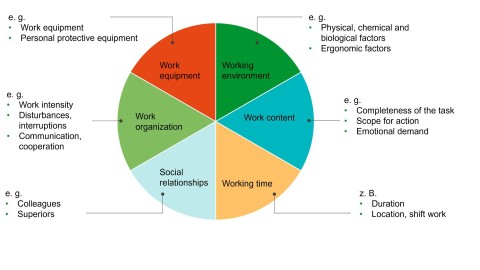Risk assessment: Mental stress in the workplace
Permanent stress and psychological strain in the workplace can have serious consequences, ranging from dwindling motivation and “inner resignation” to “burnout” and long-term psychological and physical complaints. Managers are just as affected by mental health problems as employees in administration or production. The general working atmosphere and the conditions at the respective workplace need to be put to the test in the risk assessment.
The causes of psychological stress in the workplace can be manifold. They can be rooted in interaction with colleagues or superiors, but also in the organization of work, the task or the design of the working environment.
Since 2013, Section 5 of the Occupational Health and Safety Act (ArbSchG) has required employers to record and document mental stress in the workplace and take appropriate countermeasures.
Mental stress in the workplace
The most important mental stressors in the workplace
Source: Joint German Occupational Safety and Health Strategy (GDA), 2022
Compared to other hazards, mental stress in the workplace is more difficult to measure. For example, it cannot be measured with a device like the noise level and is not visible like a tripping hazard. A good method of recording mental stress is to ask employees and managers about it.
Mental health risk assessment
1. Define areas of responsibility and activities
In order to systematically prepare the mental health risk assessment, analysis areas are defined in which all persons are exposed to similar stresses. These can be workplaces, departments, open-plan offices or production halls in which employees carry out comparable activities under the same spatial conditions.
The criteria used to define the areas of activity for the psychological risk assessment can vary from company to company. An exemplary subdivision of the fields of activity would be production, logistics, IT, administration and field service.
In addition to the management, the HR department, employee representatives (works council) and specialists from the fields of occupational medicine and occupational safety can be key players in the preparation of the psychological risk assessment.
The psychological risk assessment also requires the support of psychologists or at least psychologically trained personnel with strong communication and methodological skills. Here it is advisable – also for reasons of neutrality – to make use of external specialists.
2. Identify hazards and assess risks
Depending on the culture and size of the company and the specific requirements of the workforce, hazards can be identified and assessed in a variety of ways. Workshops, personal interviews and target group-specific questionnaires, for example, are proven methods for identifying hazards.
Employees should be involved in the risk assessment process from the outset in order to ensure broad acceptance of the associated measures. Transparent communication and constructive cooperation with employee representatives are essential to create a positive starting point. Only if employees feel that their concerns are taken seriously will they actively and sustainably support an improvement process.
The risk assessment can also take existing information into account, such as findings from previous employee surveys.
Data on the development of sickness rates and days of absence per department, on the most frequent health complaints or on employee turnover can be helpful, for example, to prioritize in which department or area the risk assessment should be carried out first.
3. Identification of suitable protective measures
In order to improve the working situation, it is necessary to evaluate the results of the employee surveys, identify areas for action and derive ideas for measures.
Workshops with experts from the fields of psychology and occupational medicine are a promising method for translating the findings into a concrete action plan. Empirical reference values, which an experienced external service provider such as Infraserv Höchst and health and accident insurers can draw on, can also be used as a guide.
4. Implement measures
The employer is responsible for implementing the necessary occupational safety measures and must take the initiative. An intact relationship of trust with the employees plays a decisive role in their implementation. This is another reason why it makes sense to bring in external and neutral experts with an “outside perspective”.
Infraserv Höchst's experts will be happy to advise you through all phases of the psychological risk assessment and can contribute to the success of the measures to be taken.
5. Review the effectiveness of the measures taken
To ensure lasting success, it is necessary to understand the psychological risk assessment not as a one-time measure, but as a continuous improvement process in a trusting dialog with those involved. Only if the effectiveness is monitored at regular intervals and employees are surveyed again at the appropriate time can it be determined whether the optimizations implemented after the risk assessment are really taking effect or whether further steps are required.
6. Updating the risk assessment
In times of digital transformation and rapid social change, the workforce is exposed to constant change in working conditions, which can also bring with it enormous psychological pressure. It is therefore necessary to continuously monitor employees in order to identify new risks to mental health at an early stage and take countermeasures.
7. Documentation
The documentation of all potential risks to the mental health of employees and the corresponding remedial measures enables the continuous optimization of all company processes in order to sustainably improve working conditions in the company.
Infraserv Höchst supports the mental health risk assessment process by providing the documentation it produces as a legally compliant basis for submission to the authorities and for continuous adaptation of improvement measures.




